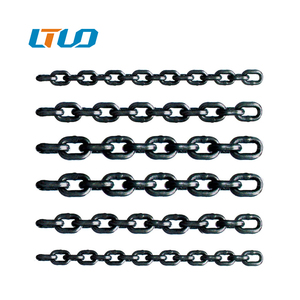(1706 products available)




























































































































































The use of mining tire chains (or mining tire track) in the tire is often classified according to the structure and shape. The classification based on use characteristics has been discussed earlier. Here, a more common classification will be looked at based on structure and shape.
Intercross chains
These types of chains include a series of links placed across the tires, which are then held by a center chain. This type of tire chain is very common in off-road vehicles. It provides a steady grip by allowing the tire to push through snow or any off-road terrain.
Ladder chains
This type of mining chain looks like the rungs of a ladder. They are formed by parallel links with cross chains linking them. Ladder chains provide traction in a straight line. They are commonly used in vehicles that face challenges in attaining traction in snowy or icy conditions. Another advantage they have is that they do not limit the speed of the vehicle. This allows miners to use vehicles with these kinds of chains in areas where snow or ice are not constant.
Diagonal (standard) chains
Diagonal chains work similarly to lug soles on a sneaker. They form an angle pattern on the tire, which provides an excellent grip on various surfaces. The chains are pretty flexible. They allow for the smooth movement of the tires in various terrains. Durability is another thing they offer. They can be used in different vehicles.
Net chains
As the name suggests, this type of chain looks like a net when it is placed on the vehicle tire. It comprises a series of interlinked chains that offers traction from all angles onto the driving surface. One of the benefits of net chains is that they provide excellent traction. Aside from that, they also offer protection for mining tires. They reduce the wear that tires experience as they roll over rough or abrasive surfaces.
The specifications for mining tire chains vary according to different types, sizes, and OEM requests. The main specifications include the link diameter and length, cross chain thickness and length, side chain length, and overall chain length.
Tire chains for mining trucks require maintenance to keep them in good condition during use and prolong their life. Regular inspections should be carried out, including checking for signs of damage or wear and ensuring all links and tensioned parts are in good condition. If any damage is found, it is better to repair or replace the parts instead of using them. Cleaning mining tire chains is also important. Users can use chain cleaners or mild detergents to remove dirt, grease, and road salt, and then dry them thoroughly. Lubrication can keep chain parts moving freely and reduce wear. When storing tire chains, please avoid choosing damp, dry, and ventilated places. It will also be helpful to re-check and clean them before and after using them for a long time.
High-impact industries such as mining, construction, and agriculture use these products. Here's how these sectors use mining tire chains.
Mining operations:
At surface and open-pit mines, heavy equipment transports materials. Chain-wrapped tires help mining trucks and loaders resist wear and grip surfaces. The chains are useful in areas with loose gravel, mud, or snow.
Construction sites:
Infrastructure-building projects often involve working on uneven or muddy terrain. With tire chains, bulldozers, loaders, and excavation trucks can move materials, clear sites, and haul confidently. The chains enhance equipment stability, traction, and efficiency.
Agricultural farms:
Farm equipment, such as tractors, may operate in muddy fields, especially after rainfall. Installing tire chains boosts the traction of farm equipment. This added grip allows for easier harvesting, plowing, and hauling in challenging soil conditions.
Logistics and ports:
Heavy vehicles transporting goods via logistical hubs or port terminals can benefit from tire chains. This is especially true when the terrain is icy or snowy. The chains enhance the traction of the truck tires, reducing the risk of delays or accidents.
Snow removal services:
Tire chains are a go-to product for applications in winter conditions. Local governments or private contractors use them on snow plows and trucks. The chains improve the grip of these vehicles on slippery roads, making snow and ice removal possible.
Rental services:
Equipment rental companies offer heavy vehicles with tire chains already installed. This is because the products are in high demand in industries that always need them for traction. Customers can use the vehicles with confidence in different terrains and weather conditions.
When selecting mining tire chains for procurement, it is essential to look at a few features. Focusing on the following factors will help one settle for chains that offer optimum performance, durability, and safety.
Q1: What are the latest trends in mining tire chains?
A1: The modern trends in mining tire chains or snow chains include durable material, automatic tensioning systems, lightweight designs, and custom designs.
Q2: How do mining tire chains affect the performance of heavy equipment in mining operations?
A2: Mining tire chains improve the performance of heavy equipment by providing a better grip, enhancing tire durability, and promoting self-cleaning.
Q3: Can mining tire chains be repaired, or is it always necessary to replace them?
A3: Minor damages to mining tire chains can be repaired. However, if there is a major damage or if the chains are worn out, it is better to replace them.
Q4: What is the lifespan of mining tire chains with regular use?
A4: The lifespan of mining tire chains depends on the material, usage, and maintenance. It can last between one to three years with regular use and proper maintenance.